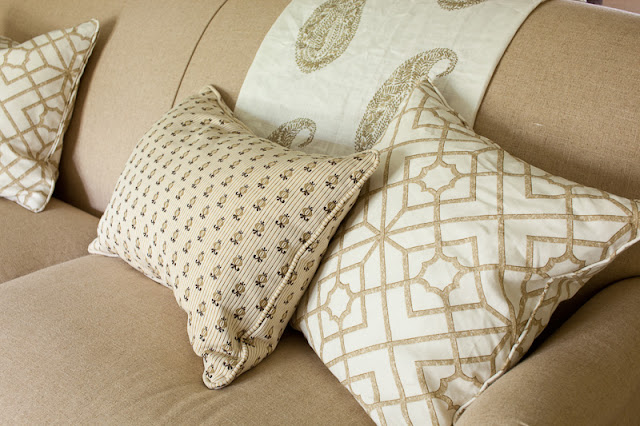Price Points & Fabrics
Well, it’s been 2 days since we launched the online fabric store and I just wanted to say thank you so much to all of you for your kind words, comments & all the fabric orders!!! I’m really blown away by all of the support and appreciate you all so much!!
I received a comment about the “sticker shock” one reader got when she headed over to the Pure Style Home Shop to view fabrics & she asked me what I thought about the price point & using it in my own home and in clients’ homes. I have to say that I really appreciate this commenter’s honesty and of course, with a price point of $120/ yard for our fabrics, I knew this would be an issue and have mentioned it serveral times before on the blog, but I thought now that the fabric line has actually launched, it would be a good time to talk about price points & what all goes into it.
First question- Do I have fabrics that cost this much in my own home? Yes.
Do I use them in client’s homes? Yes, in pretty much every single project…. BUT, my client’s budgets determine where the fabric will go. For example, right now in a tight budgeted living room we’re working on with a client, we are using a $275/ yard Ralph Lauren fabric in the room but it’s going on a pillow so we need only 1 yard.
Statement fabrics play such an important role in creating a vibe & a mood in a room and showing a family’s personality, that for me they’re really one of those “splurges” that we typically recommend making in a room. We may use pieces from Ikea or Target in a room but the little shot of the perfect fabric in there (whether it be $25 or $250/ yard ) is what brings the room up and makes it personal & right. We often use the most expensive fabrics on the pillows to keep the budget down, while still getting that perfect fabric in our rooms.
Do I love it when amazing fabric can go on the curtains? Yes!! But is it always practical for the budget? Nope.
In my own house I have off-the-rack cheapie curtains from Ikea along with curtains I made myself out of inexpensive white linen, but I have awesome pillows 😉 Some of my favorite pillows in my house are $200+/ yard and some of the others were $10 thrift store fabric finds… The cost isn’t the determining factor for me because if it’s pillows, you only need a yard.
It’s all a matter of what’s important to you & what you value and where you decide to put your money in a room. And beautiful rooms can be created at virtually any price point. No one needs decorative pillows to survive, but most of us have them anyway.
The next question that I’ve just learned the answer to myself through this crazy process of creating a line of textiles is: Why do fabrics cost what they do? I often wondered why I could buy a Duralee print for $30/ yard and then buy a Schumacher for $120/ yard? Was it because the Schumacher people were just making waaaaaaaay more money? But there’s so much more that goes into it than that.
I’ve learned about mills & jobbers and open textile designs and exclusive textiles designs and the difference in mass-produced and smaller companies… I’m still learning and it’s kind of confusing but this is what I’ve gotten out of it all so far: There are companies out there who make “open” prints. They mass-produce fabrics and sell them to as many textile companies as they can. Kravet, Duralee, Fabricut, Calico Corners and others can all buy the same prints and sell them under their own names. The prints cost less because the print is “open” and anyone can buy it. It’s basically up for grabs. This is why you might see Kravet and Fabricut carrying the same fabric.
There are other mass-produced designs that the big textile companies buy that are “exclusives.” They buy the design (maybe for just a period of time in some cases) and they are the only ones selling it. This is good for them because they don’t have competitors selling the same product. Lots of times these exclusive designs are by certain designers and they also have rights to use the designer’s name on the fabric collection. This of course, adds to the cost because the designer has to get paid royalties too.
…Keep in mind that all of these instances deal with fabrics that are massed-produced in huge quantities. These big fabric companies are carried all across the US in showrooms and retail stores and are very popular. Because they are producing & selling so many yards of fabric, the production and materials cost per yard is very low so that it’s still low by the time it gets to the general public.
For boutique and smaller companies (like me!) the production costs are much higher. If you are producing in smaller runs and have a smaller market, it just costs more to produce per yard. Add high quality linen & printing procedures and you have a more expensive end product. I could never have afforded to do a mass-produced line. It’s been a while since I got the information, but if I remember tallying up what it would cost to set up 1 design in 1 colorway and print a certain number of thousands of yards, it was something like $20,000- $30,000!! (Ending up with a fabric collection that would have cost me a cool 1.5 +/- million in investments. ouch! But just not possible. We’ve invested a lot to create our fabric line, but nowhere close to 1.5 😉
If you are buying mass-produced items, you get the price benefit of everyone else’s dollars combined with yours to make a less expensive item. If you’re buying items from smaller companies, with smaller markets, you don’t have that benefit, but you are receiving something that not as many people have, so it’s a bit more unique. Pros & cons to both. It’s a bit like Home Depot vs. your local hardware store or Superwalmart groceries vs. your local grocery store groceries. Walmart’s stuff is cheaper because there are Walmarts everywhere. The local grocery stores selling items at higher prices aren’t making more, they’re just paying more so they have to sell their goods at higher prices. It’s up to you which way you decide to go where you spend your money. I don’t think either is right or wrong, but some people have very strong opinions one way or the other.
Another thing I’ve learned is that fabric (or any product really) passes through many hands before it reaches the end consumer. When we buy things from a retailer, they are marking it up. They have to. It’s how they stay in business.
There are lots of different ways that fabrics are sold & the internet is often making a direct connection between fabric companies & the end user, but in general, this is what I’ve noticed the exchange of goods normally looks like:
Production Cost –> Fabric Company –> Fabric Showroom –> Decorator –>End user
Production Cost–> Fabric Company–> Retailer–> End User
There are retail prices marked on many items & typically, you can find things at just below retail on the internet, in effect, creating a new, slightly lower retail price. But basically, the real retail or the lowered retail price is the price that most end users pay for fabrics whether they buy through a retailer or a decorator selling at those prices. (Decorators all charge differently & have different contracts so this isn’t always the case.)
So when the final retail price for a fabric is determined, it’s based upon:
first, giving the showroom a price
next, creating a trade-only price
and finally, determining the final retail price
or just going from retailer to final retail price. (If you think about it, retailers are getting a very good price from companies, but retailers typically have more overhead than showrooms and designers because retail rents are usually fairly high, so they need to mark up more to stay in business, ending up with that same retail price everyone else is selling at. ALTHOUGH.. A lot of online stores are putting retailers out of business now because they don’t have that overhead but are still getting those prices from wholesalers… world’s a changing!)
As I just mentioned, the internet has provided a direct link from companies to the end users, but in order for companies to remain loyal to the people selling their product and not, “cut them out,” companies need to be sure not to undercut their distributors (ie showrooms, decorators and retailers.) It would be very easy to cut out all the “middle men” from the equation, but in the end , then they would have no one but themselves selling their products & depending upon their business model, it could be difficult to stay in business.
I thought long and hard before deciding how I wanted to sell my fabrics. I thought about just selling online retail myself. I thought about taking my designs to a large company & selling them, virtually having no fabric company but getting paid for my designs and trying to keep my name attached and being able to retail my fabrics online at lower prices along with anyone else who wanted to retail them. And I thought about selling through showrooms and select retail stores…
It took me a while to make the decision, but for now I have decided that I want to keep control of my line &
my designs and I think the company itself. In the end, because of this decision not to go mass-produced, my fabrics will not be as affordable as I wish they could be and not everyone will be able to buy them. It’s a fact I wish I could change and I would looove for everyone to be able to afford yards & yards of them. I truly do. But it’s not reality.
It’s also important to me to support & protect those companies & people selling my products because they are the ones really getting it done. As a decorator myself, I appreciate companies that offer trade pricing and I wanted to be able to do the same for decorators who want to use our products.
And I know there are those out there who are not in the interior design trade who think that they should get wholesale & trade pricing on everything they buy, but I don’t think that’s very fair. Designers buy thousands & thousands of products per year and build relationships with the companies they work with to get the trade pricing they have access to. It’s how they make their living. I think it’s unfair for someone in an unrelated field to expect that they should be able to get the same price that a distributor of a product gets. (Don’t hate me if you’re one of those people please!! 🙂
I want a deal as much as the next person, but when I buy my clothes from say Macy’s or Nordstrom, I don’t get employee discounts because I don’t work at either of those places. And I don’t expect one either. It’s the same thing when buying goods for the home. When a decorator buys something from a company for a client or a showroom purchases something, they are selling a product for that company and they get that discount / they get paid for selling the product.
And the fact is that almost everything you buy passes through multiple hands before it reaches yours. (Most companies just don’t lay it out the way I just did because it can scare people away… I hope I didn’t scare you away though!!)
Anyway, I’m still learning and it’s all very new to me. But this is what I’ve gotten out of it all so far. I hope this explains how we’ve determined our price & I hope it makes sense to you. It’s so important for me that anyone who buys our fabrics feels that they are worth what they are paying for and that they’re happy with their decision.
Anyway, I’m off for the day but don’t forget to enter the LL Textiles giveaway if you haven’t already! It ends Friday & click here to enter.

If you’d like help creating a home you absolutely love, contact me about our design services.











azithromycin 250mg
cialis 10 mg tablet
cialis online no prescription
… [Trackback]
[…] Read More Information here to that Topic: laurenliess.com/pure-style-home/price-points-fabrics/ […]
… [Trackback]
[…] Find More on to that Topic: laurenliess.com/pure-style-home/price-points-fabrics/ […]
… [Trackback]
[…] Here you will find 20091 additional Information to that Topic: laurenliess.com/pure-style-home/price-points-fabrics/ […]
… [Trackback]
[…] There you can find 14579 more Info on that Topic: laurenliess.com/pure-style-home/price-points-fabrics/ […]
… [Trackback]
[…] Here you can find 5398 additional Information to that Topic: laurenliess.com/pure-style-home/price-points-fabrics/ […]
… [Trackback]
[…] Read More on on that Topic: laurenliess.com/pure-style-home/price-points-fabrics/ […]
… [Trackback]
[…] Read More on that Topic: laurenliess.com/pure-style-home/price-points-fabrics/ […]